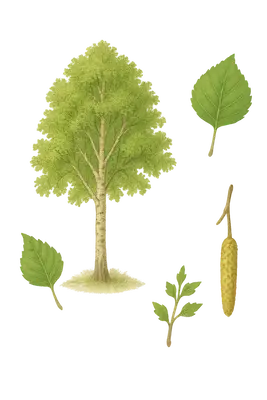Birch (Tree)
Description
Birch trees (Betula species) are slender, medium-sized deciduous trees easily identified by their distinctive white or silver bark that often peels into thin layers. They typically have triangular-shaped leaves and produce abundant wind-dispersed pollen during the spring months. Birch pollen is among the most potent allergens and can travel long distances on the wind.

Allergy Symptoms
Birch pollen is highly allergenic, commonly causing:
- Severe nasal congestion
- Frequent sneezing
- Itchy, watery eyes
- Throat irritation and coughing
- Exacerbation of asthma symptoms
Birch pollen allergies frequently trigger Oral Allergy Syndrome, causing an itchy mouth and throat when consuming raw apples, pears, peaches, carrots, and nuts due to similar proteins found in these foods.
Typical Pollination Period
Birch trees typically pollinate from late March through May, peaking in April across most temperate regions in the Northern Hemisphere. Pollination starts earlier in warmer climates and may extend later in colder, northern climates.
Geographic Distribution
Birches are widespread across the temperate Northern Hemisphere:
- Europe: especially common across Northern and Central Europe.
- North America: prevalent in Canada, Northeastern, and Northern United States.
- Asia: extensive presence throughout Siberia, Northern China, Korea, and Japan.
Tips for Reducing Exposure and Managing Allergies
- Monitor local pollen forecasts and reduce outdoor activities during peak pollen days.
- Keep indoor environments pollen-free by closing windows and using air purifiers.
- Shower and change clothes immediately after being outdoors.
- Begin antihistamines and nasal sprays proactively before symptoms start.
- Consider allergy testing and immunotherapy for long-term relief.